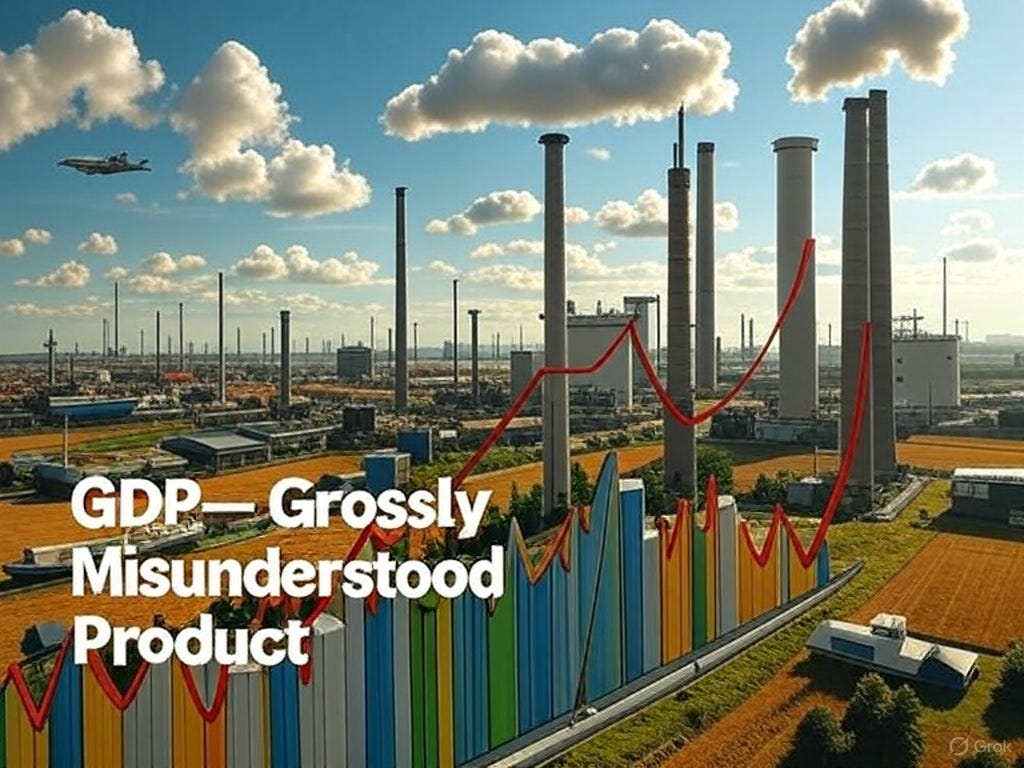GDP— Grossly Misunderstood Product
Let this piece be an invitation to rethink, reflect, and reimagine what truly defines the prosperity of a nation.
Grossly Misunderstood Product
Why It’s Time to Rethink What We Measure—and Why We Measure It
By Karan Bir Singh Sidhu
We’ve come to accept GDP—Gross Domestic Product—as the ultimate scoreboard of national success. But maybe it’s time we stopped treating it as a proud output of progress and started seeing it for what it really is: a badly managed product that no responsible Product Manager today would sign off on.
Gross doesn’t mean “great”—it means crude, unrefined, like raw ore or buggy code. And Product? It’s not something built or tested. It’s just a formula—consumption times investment, plus spending and trade. More spreadsheet than substance.
So yes, the pun is intentional. GDP isn’t just a flawed metric—it’s a Grossly Misunderstood Product. And perhaps it’s time we gave it a serious product review.
A Civil Servant’s Journey into Economics
I must confess: I did not come to economics by the usual path. I began as an engineering graduate before transitioning into public service. It was only after my tenure as Deputy Commissioner, Amritsar, that I ventured to the University of Manchester in 1996–97, under the Colombo Plan, to pursue an MA Economics in Development Administration and Management at the Institute for Development Policy and Management. There, we were taught the general principles of economics—but rarely ventured into the deeper waters of microeconomics, equilibrium theories, or the mathematical precision of marginal utility.
To this day, I wonder why differential calculus—so natural for dealing with infinitesimal changes and rates of growth—is not more rigorously applied in economics. Time, after all, is intrinsic to understanding economic flows and transformations.
What GDP Ignores
GDP is often described in neat formulas and explained through elegant graphs. Yet, it has several blind spots. It does not account for changes in personal or national wealth when such changes do not arise from officially recorded "production."
Consider the following: the stock market surges by 25% over a few months. If this rise is purely valuation-based, GDP registers no change—yet the real wealth of equity holders has grown. These individuals can convert their gains into cash and feel significantly richer, but national accounts stay silent.
Or take agricultural land. In a state like Punjab, land prices may double or triple over a few years. For the landowner, this is a windfall—real wealth that transforms financial security. Still, because it doesn't show up as “income,” GDP remains unmoved.
Even the surging value of gold—held in households or enshrined in ancient temple treasuries—escapes the attention of GDP metrics. If asset values can soar without touching GDP, then what exactly are we measuring?
Today, even cryptocurrencies and digital assets like Bitcoin pose a dilemma. Their market values may skyrocket or crash, yet many national GDP systems either ignore them altogether or inconsistently classify them—despite their growing role in private wealth and financial flows.
Goodhart’s Law and the Cobra Capital of Confusion
This is where Goodhart’s Law becomes a cautionary principle: “When a measure becomes a target, it ceases to be a good measure.” Once GDP becomes the sole barometer of national success, systems start gaming the metric. We inflate the indicator, not the reality.
A historical parable that illustrates this perfectly is the Cobra Effect. During colonial rule in India, the British incentivized the killing of cobras by offering bounties. Enterprising individuals began breeding cobras to kill them for cash. When the government caught on and ended the policy, the breeders released their now-worthless snakes—exacerbating the problem. When policymakers chase GDP for its own sake, rather than for what it represents, they risk creating similar distortions: financial bubbles, artificial boosts, and skewed development priorities that backfire.
Time, Efficiency, and Lost Opportunities
Another blind spot is time. The same industrial or IT project, executed more efficiently—say, in 75% of the time—yields greater economic momentum. Regulatory reforms that shave months off project approvals can, in theory, increase effective GDP by a significant margin. Yet, we rarely evaluate this gain.
The speed of execution is a key variable, but GDP often registers outcomes, not process improvements. A nation becoming faster and smarter should see its economic health reflected in its national accounts. But we don’t currently measure that.
The Curious Case of Home Labor and Invisible Work
Then there are the everyday paradoxes. Two sisters-in-law in a joint family take care of each other’s children. No money changes hands. No economic transaction takes place. According to GDP, nothing has happened.
But imagine they start "employing" each other, each paying ₹10,000 per month for babysitting services. Suddenly, there's a ₹20,000 addition to GDP—despite no change in actual labor or output. So what changed? Just the monetization of a social arrangement.
There is, in fact, a vast literature arguing that unpaid domestic labor—primarily performed by women—is an unrecognized pillar of the economy. If these activities were formalized, the GDP would rise significantly. But we continue to ignore this silent contribution.
Measuring the Unmeasurable?
This brings me to a fundamental question: can we develop more meaningful metrics?
To be fair, we do have tools like the Human Development Index (HDI), Happiness Index, and other composite indicators. But these sit on the periphery of policymaking. It is still the GDP—blunt, blind, and yet dominant—that governs how we evaluate debt levels, fiscal health, and economic planning.
Worse, GDP often conflates turnover with income. It measures the flow, not the stock. It captures activity, not necessarily value addition. It fails to reflect wealth accumulation, asset inflation, time-efficiency, and the structural underpinnings of real economic power.
A Plea for a Better Metric
I make no claims to offer a ready-made solution. I’m neither a statistician nor a practicing economist. But I do believe that we need something better—something simpler, more holistic, more intuitive.
Why not attempt a system that focuses on real income, wealth mobility, and distribution-adjusted growth? Why must we rely on a tool that was devised in the 1930s to serve wartime economies, and treat it as gospel in the era of AI and blockchain?
Remittances from overseas Indians flow into the country. Do we know how much of this is debt, how much is investment, how much is gift? Often, we do not distinguish. GDP merely notes the inflow.
The world has changed. Our tools must evolve.
In Conclusion
We are in an age of digital revolutions and real-time intelligence. Yet, our economic measurements remain primitive. The time has come to think differently. Perhaps the solution lies not in complex equations or abstract summations, but in adopting a broader view—one that sees the economy not just as a machine of outputs, but as a living organism of value, well-being, and wealth.
As I often say, it is better to be approximately correct than to be precisely wrong.
Let this be an invitation to rethink, reflect, and reimagine what truly defines the prosperity of a nation.






Nicely written sir.